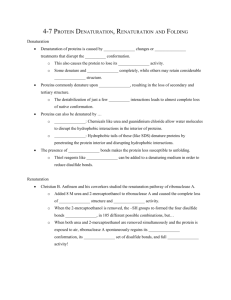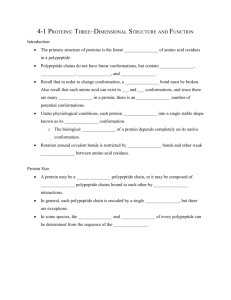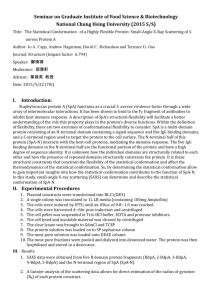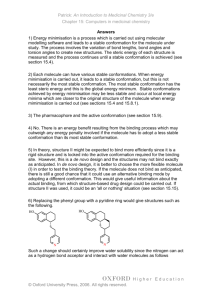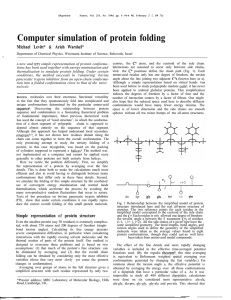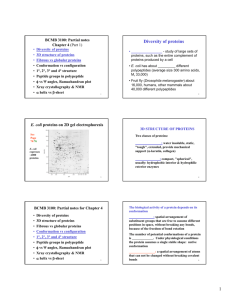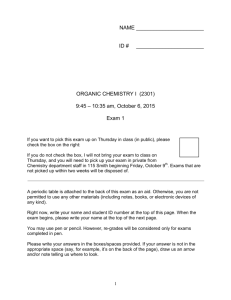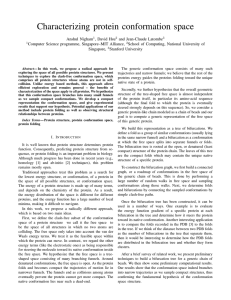Chapter 4 Summary
advertisement
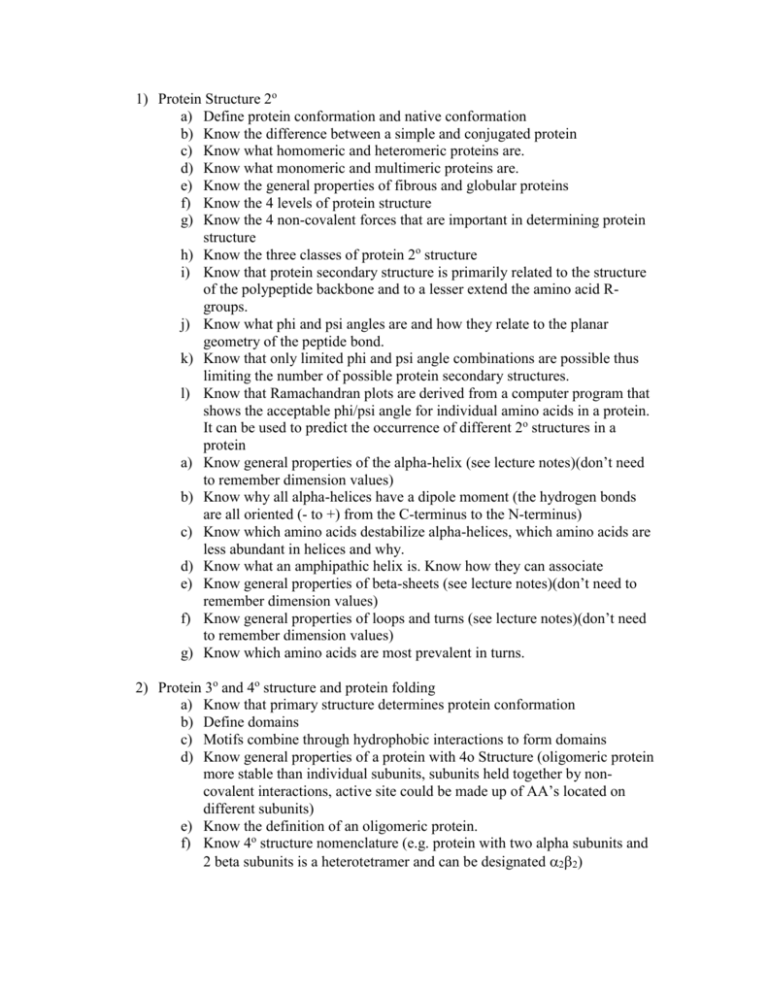
1) Protein Structure 2o a) Define protein conformation and native conformation b) Know the difference between a simple and conjugated protein c) Know what homomeric and heteromeric proteins are. d) Know what monomeric and multimeric proteins are. e) Know the general properties of fibrous and globular proteins f) Know the 4 levels of protein structure g) Know the 4 non-covalent forces that are important in determining protein structure h) Know the three classes of protein 2o structure i) Know that protein secondary structure is primarily related to the structure of the polypeptide backbone and to a lesser extend the amino acid Rgroups. j) Know what phi and psi angles are and how they relate to the planar geometry of the peptide bond. k) Know that only limited phi and psi angle combinations are possible thus limiting the number of possible protein secondary structures. l) Know that Ramachandran plots are derived from a computer program that shows the acceptable phi/psi angle for individual amino acids in a protein. It can be used to predict the occurrence of different 2o structures in a protein a) Know general properties of the alpha-helix (see lecture notes)(don’t need to remember dimension values) b) Know why all alpha-helices have a dipole moment (the hydrogen bonds are all oriented (- to +) from the C-terminus to the N-terminus) c) Know which amino acids destabilize alpha-helices, which amino acids are less abundant in helices and why. d) Know what an amphipathic helix is. Know how they can associate e) Know general properties of beta-sheets (see lecture notes)(don’t need to remember dimension values) f) Know general properties of loops and turns (see lecture notes)(don’t need to remember dimension values) g) Know which amino acids are most prevalent in turns. 2) Protein 3o and 4o structure and protein folding a) Know that primary structure determines protein conformation b) Define domains c) Motifs combine through hydrophobic interactions to form domains d) Know general properties of a protein with 4o Structure (oligomeric protein more stable than individual subunits, subunits held together by noncovalent interactions, active site could be made up of AA’s located on different subunits) e) Know the definition of an oligomeric protein. f) Know 4o structure nomenclature (e.g. protein with two alpha subunits and 2 beta subunits is a heterotetramer and can be designated 22) g) Be able to determine the subunit composition of an oligomeric protein using information obtained from gel permeation chromatography and SDS PAGE analysis. h) Define denaturation, Tm i) What are the thermodynamic factors favoring and hindering protein folding. How do hydrophobic interactions drive protein folding. j) Proteins are not static, they breath between conformations but prefer to be in lowest energy conformation k) Proteins fold towards lowest energy conformation. l) There are multiple paths towards the lowest energy conformation m) Know the pathway of protein folding (see lecture notes) n) Know general properties of chaperonins o) Know when disulfide linkages form during protein folding. p) What is the role of disulfide bonds in protein structure? q) Know what type of proteins have disulfide linkages 3) Protein structure function a) Structure of myoglobin and hemoglobin similar b) Understand oxygen binding curves (where high and low affinity binding occurs) c) Understand positive cooperatively in relationship to oxygen binding to hemoglobin, be able to describe this in relationship to protein conformation and the sigmoidal oxygen binding curve d) Be able to describe T and R conformations of Hb e) Understand how oxygen binding changes Hb conformation f) Define allosteric interaction. g) Know where allosteric effectors bind h) Know the allosteric inhibitors of Hb i) Be able to describe the Bohr Effect. j) Know how change in pH can alter protein conformation k) Describe carbamation of N-terminus of Hb and describe how this can alter protein conformation. l) Describe how bisphosphoglycerate (BPG) functions as an allosteric effector of Hb. What advantage does BPG give to high altitude climbers and the fetus. m) Understand ho a Glu to Val change can cause sickle cell anemia.
